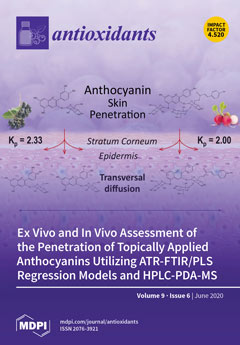The aims of this study were to investigate the effect of vitamin D
3 administration in drinking water during lairage time prior to slaughter on physiological stress, oxidative status, and pork quality characteristics. Two experiments were carried out. The first one was performed to examine the effect of vitamin D
3 supplementation in drinking water, and the second one to check the effect of supplementation dose (500,000 IU/L vs. 700,000 IU/L). Serum calcium concentration was greater in pigs receiving vitamin D
3 in water when compared to the control group. In experiment 1, a 40% α-tocopherol increase in meat from the group supplemented with vitamin D
3 (500,000 IU/animal) was observed, that resulted in a tendency of decreased meat malondialdehyde (MDA) values at days 5 and 8 after refrigerated storage. In experiment 2, since water intake was higher (800,000 IU and 1,120,000 IU/animal of vitamin D
3 consumption) effects on oxidative status were more profound and vitamin D
3 supplementation increased serum α-tocopherol and decreased cortisol and serum TBARS. These effects were also observed in meat; TBARS levels were decreased after 3 days of refrigerated storage. In both experiments meat from pigs that received vitamin D
3 in drinking water had a lower proportion of total free-polyunsaturated fatty acids (mainly n-6) when compared to the unsupplemented pigs, and these were positively correlated with TBARS production at day 5 of refrigerated storage (
r = 0.53 and 0.38 for experiments 1 and 2, respectively). Meat from pigs receiving vitamin D
3 in water showed reduced cohesiveness, gumminess, and chewiness values compared to the control group. The magnetic resonance imaging study of muscle confirmed the effects on water retention with lesser transverse relaxation time in pigs supplemented with vitamin D
3. No vitamin D
3 dose effect was observed, apart from muscle α-tocopherol concentration that was higher in pigs supplemented with 700,000 compared to those supplemented with 500,000 UI/L.
Full article






